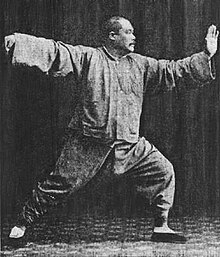T'ai chi ch'uan

|
|

Yang Chengfu in a posture from
the Yang-style t'ai chi ch'uan solo form known as Single Whip c. 1931 |
|
| Also known as | Taijizhang; t‘ai-chi; taiji |
|---|---|
| Focus | Chinese Taoist |
| Hardness | Forms competition, Light contact (pushing hands, no strikes), Full contact (strikes, kicks, throws, etc.) |
| Country of origin | China |
| Creator | Said to be Zhang Sanfeng |
| Famous practitioners |
Chen Wangting, Chen Changxing, Chen Fake, Yang Lu-ch'an, Yang Chengfu, Wu Ch'uan-yu, Wu Chien-ch'uan, Wu Yu-hsiang, Sun Lu-t'ang, Wang Pei-sheng |
| Olympic sport | Demonstration only |
| Tai chi | |||||||||||||||||||||||||||||

"Taiji quan" in Traditional (top) and Simplified (bottom) Chinese characters
|
|||||||||||||||||||||||||||||
| Traditional Chinese | 太極拳 | ||||||||||||||||||||||||||||
|---|---|---|---|---|---|---|---|---|---|---|---|---|---|---|---|---|---|---|---|---|---|---|---|---|---|---|---|---|---|
| Simplified Chinese | 太极拳 | ||||||||||||||||||||||||||||
| Literal meaning | "Supreme Ultimate Boxing" | ||||||||||||||||||||||||||||
|
|||||||||||||||||||||||||||||
| Transcriptions | |
|---|---|
| Standard Mandarin | |
| Hanyu Pinyin | Tàijí quán |
| Wade–Giles | T'ai4-chi2 ch'üan2 |
| IPA | [tʰâi.tɕǐ tɕʰɥɛn] |
| Wu | |
| Suzhounese | Thǎ-jíh jʏǿ |
| Yue: Cantonese | |
| Yale Romanization | Taai-gihk kyùhn |
| IPA | [tʰāːi kɪ̀k kʰy̏ːn] |
| Jyutping | Taai3-gik6 kyun4 |
| Southern Min | |
| Hokkien POJ | Thài-ke̍k kûn |
| Tâi-lô | Thài-ki̍k kûn |
T‘ai-chi (Mandarin: tàijí 太極, an abbreviation of tàijí quán 太極拳, literally "Supreme Ultimate Boxing") is an internal Chinese martial art 武术 practiced for both its defense training and its health benefits. Though originally conceived as a martial art, it is also typically practiced for a variety of other personal reasons: competitive wrestling in the format of pushing hands (tui shou), demonstration competitions, and achieving greater longevity. As a result, a multitude of training forms exist, both traditional and modern, which correspond to those aims with differing emphasis. Some training forms of t‘ai-chi ch‘üan are especially known for being practiced with relatively slow movements.
Today, t‘ai-chi ch‘üan has spread worldwide. Most modern styles of t‘ai-chi ch‘üan trace their development to at least one of the five traditional schools: Chen, Yang, Wu (Hao), Wu, and Sun. All of the former, in turn, trace their historical origins to Chen Village.
The concept of the taiji ("supreme ultimate"), in contrast with wuji ("without ultimate"), appears in both Taoist and Confucian Chinese philosophy, where it represents the fusion or mother of yin and yang into a single ultimate, represented by the taijitu symbol ![]() . T‘ai-chi ch‘üan theory and practice evolved in agreement with many Chinese philosophical principles, including those of Taoism and Confucianism.
. T‘ai-chi ch‘üan theory and practice evolved in agreement with many Chinese philosophical principles, including those of Taoism and Confucianism.
...
Wikipedia
